Weekly Significant Activity Report - October 25, 2025
This week’s analysis highlights some of the most significant geopolitical developments involving America’s adversaries between October 18 - 25, 2025.
Summary:
Russia again rebuffed US mediation efforts to end the war in Ukraine short of its maximalist goals. Russia has slightly modified its diplomatic efforts to attain its war aims by pursuing a multi-faceted diplomatic strategy to divide the US, Europe, and Ukraine, and deter the US from escalation through indirect nuclear signaling.
The Chinese Communist Party conducted its Fourth Plenum of the 20th Central Committee. The plenum addressed both internal Party issues and the formulation of the 15th Five-Year Plan which begins in 2026. The composition of the Central Committee and the wording of the official communique highlight Xi’s increasingly absolute power within the CCP.
China accused the US of a prolonged cyber espionage campaign against its National Time Service Center.
A new report released by the Institute for Science and International Security identified new construction at a previous secret Iranian nuclear weapons research site near Tehran.
North Korea conducted its first missile test in months. Pyongyang claims the launch was the first test of its new hypersonic missiles.
1. RUSSIA RESISTS US PRESSURE FOR PEACE, FOCUSES EFFORTS ON DIVIDING US AND EUROPE
Talks Between Trump and Putin Off, Sanctions On, as Kremlin Denies Openness to Freezing Conflict
This week the US called off a potential second meeting between President Trump and President Putin after Russian Foreign Minister Sergei Lavrov contradicted suggestions by President Donald Trump that the war could end along current lines in a preliminary discussion with Secretary of State Marco Rubio.
Lavrov reiterated Russia’s position in an October 21 news conference:
The special military operation “is fulfilling its goals: There is no doubt that it will conclude successfully.”
A ceasefire promoted by Europe and Vladimir Zelensky would leave much of Ukraine under Nazi control: “An immediate ceasefire, the talk of which has suddenly reappeared, would mean only that a large part of Ukraine remains under the Nazi regime’s control, while the need is to resolve the issue at its core and address its underlying causes.”
In response, on October 22, the US imposed sanctions on Lukoil and Rosneft and their subsidiaries and threatened secondary sanctions on their business partners.
Russian Strategic Forces Conduct Annual “Grom” Exercise
On October 22, Russia completed its annual “Grom” exercise, testing the ground, air, and sea components of its nuclear forces.
According to a Kremlin Press Release:
“Under the leadership of Supreme Commander-in-Chief of the Armed Forces of the Russian Federation, Vladimir Putin, a strategic nuclear forces exercise was conducted involving their land, sea, and air components. During the exercise, practice launches of intercontinental ballistic missiles and air-launched cruise missiles were conducted.
“A Yars intercontinental ballistic missile was launched from the Plesetsk State Test Cosmodrome toward the Kura range in Kamchatka. A Sineva ballistic missile was launched from the Bryansk nuclear-powered ballistic missile submarine in the Barents Sea. Tu-95MS long-range aircraft also participated in the training, launching air-launched cruise missiles. The practice launches were controlled by the National Defense Control Center of the Russian Federation.”
Test of the Yars Intercontinental Ballistic Missile. Source: Russian Ministry of Defense (@mod_russia) on Telegram
Russian President Vladimir Putin Refuses to Cave to Pressure and Threatens Response to Sanctions and Tomahawk Missiles
On October 23, Putin announced that no amount of pressure would cause Russia to abandon its war in Ukraine. Putin further emphasized that Russia would provide a “strong if not overwhelming” response to Tomahawk cruise missiles being delivered to Ukraine.
Russian Jets Violate Lithuanian Airspace
On October 23, Lithuania announced that it had detected a Russian Su-30 fighter and Il-78 refueling tanker enter its airspace near the border with Kaliningrad.
Moscow Dispatches Special Envoy Kirill Dmitriev to the US for Talks
On October 24, two days after the US imposed new sanctions on Russian oil giants Lukoil and Rosneft, CNN reported that Kirill Dmitriev arrived in the United States for discussions with several Trump administration officials regarding the state of U.S.-Russia relations. According to Dmitriev, the talks, which included Steve Witkoff and Republican Representative Anna Paulina Luna of Florida, were scheduled before the sanctions were reinstated and may have been initiated by Witkoff and Luna.
Takeaways:
On Russia’s Negotiating Position:
The Kremlin has assessed it cannot end the war under the current conditions and appears to be pursuing a dual track negotiating strategy. The first track is pursuing a no compromise negotiating position with Ukraine and its Western partners. This effort is led by Sergei Lavrov and Russia’s seasoned foreign policy establishment.
The second track is being pursued by special envoy Kirill Dmitriev. Dmitriev, a Western-educated financier, appears to be focused on appealing to credulous US officials that the US-Russia relationship is unnecessarily strained by the war, and that this strain is being driven primarily by manipulation by Europe.
In an October 25 interview with TASS, Dmitriev said he planned on emphasizing to American officials that Ukraine, at the EU’s urging, was stalling peace negotiations to continue the war to weaken Russia.
“It’s crucial that we see that Ukraine is dragging its feet on the negotiations. Ukraine is unwilling to resolve the problems, the accumulated issues that need to be addressed,” Dmitriev noted.
“And therefore, we will also convey to our American colleagues that Ukraine, unfortunately, is disrupting the dialogue that is necessary. And it is disrupting it, again, at the request of the British, at the request of the Europeans, who want the conflict to continue.”
The Kremlin continues to feign indifference to US economic pressure, but the sanctions on Lukoil and Rosneft pose a substantial threat to its faltering economy. Combined, Lukoil and Rosneft produce half of Russia’s oil. The newest US sanctions package threaten not only the companies but their Russian-controlled subsidiaries such as Bulgaria’s Burgas Refinery. There is also a clause in the sanctions package that threatens the customers of these companies, a development which has apparently stopped (at least temporarily) the purchase of Russian oil by Chinese and Indian refiners.
On New Russian Threats:
Putin’s newest threats are far less menacing than the rounds of nuclear saber rattling previously invoked to defend Moscow’s “redlines” on weapons shipments to Ukraine.
The threats initially appeared substantial as they were made within hours of the violation of NATO airspace by Russian warplanes. However, further information about this incident suggests that the breach may have been genuinely accidental. The two Russian aircraft involved crossed 700m into Lithuanian airspace—in an area of extremely complex borders—for less than 18 seconds after returning from training.
The Grom exercises, while a vivid reminder of Russia’s nuclear capabilities, are held annually. The airspace closures for the drills were scheduled for between October 20-24, suggesting that preparations for the Grom exercise were made well before the newly imposed US sanctions and subsequent downturn in relations.
It is worth noting, however, that Grom is the second nuclear test Russia appears to have planned to coincide with a meeting between Russian President Vladimir Putin and US President Donald Trump in recent months. This week’s meeting between the two leaders, while ultimately canceled, was initially slated for October 23rd, during the four-day window of airspace closures Russia set aside for Grom. Russia scheduled and then extended similar airspace closures for an anticipated test of the experimental nuclear-powered, nuclear-armed “Burevestnik” cruise missile days prior to the August 15 Alaska Summit.
This suggests that the Kremlin may be continuing to use coercive nuclear signaling to pressure US leaders into avoiding actions that will further deteriorate US-Russia relations, but in more subtle ways. Russia may have adopted this new and more indirect approach after President Trump’s public spat with Former Russian President Dmitri Medvedev in July over the latter’s casual use of nuclear threats. Trump claimed to have adjusted the posture of US nuclear submarines in response to Medvedev’s statements and forced a climb down by the Kremlin.
2. CHINA COMPLETES FOURTH PLENUM OF THE 20TH CENTRAL COMMITTEE
The 20th Central Committee of the Chinese Communist Party (CCP) held its Fourth Plenum this week. Party plenums are periodic political strategy sessions used to guide governance in China by bringing officials across the CCP into line with the dictates of the Party’s core leaders.
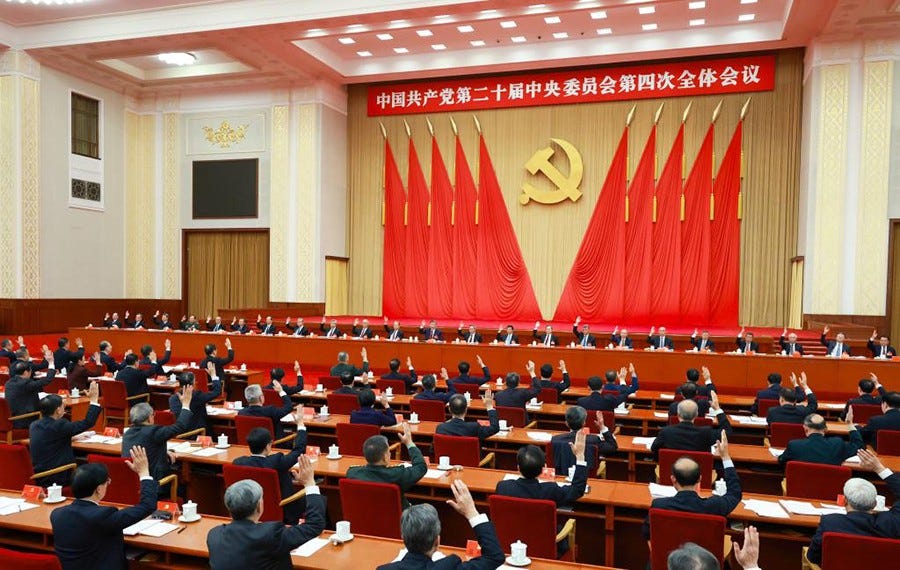
Takeaways:
The CCP holds seven Central Committee plenums for each five-year term of the National People’s Congress. Plenums typically address the following topics in sequences according to the Center for Naval Analysis (CNA):
First Plenum - Party Personnel Appointments
Second Plenum - Government personnel appointments
Third Plenum - Economic policy and related reforms
Fourth Plenum - Legal or Party issues
Fifth Plenum - Five-year plans
Sixth Plenum - Ideological issues
Seventh Plenum - Preparations for the next National Party Congress
This plenum follows the long delayed Third Plenum, and appears to have addressed both internal Party issues and the upcoming 15th Five-Year Plan running from 2026 to 2030.
Party and Legal Issues Addressed:
The Fourth Plenum emphasized the centrality of Xi Jinping’s leadership in the CCP, both directly in its official communiques, and indirectly in the composition of the Central Committee members in attendance.
First, the official communique stressed the need for Party members to develop a “deep understanding of the decisive significance of establishing Comrade Xi Jinping’s core position on the Party Central Committee and in the Party as a whole and of establishing the guiding role of Xi Jinping Thought on Socialism with Chinese Characteristics for a New Era.”
As can be seen below, this description, which appears for the first time in the communique for the Third Plenum, is significantly stronger than language used at the end of the 19th Central Committee plenums. It is another indication, along with numerous references to Xi Jinping Thought (a category of political doctrine previously reserved only for Mao Zedong) that Xi is a leader who transcends the norms and Party politics that have constrained Chinese leaders since Mao’s death.
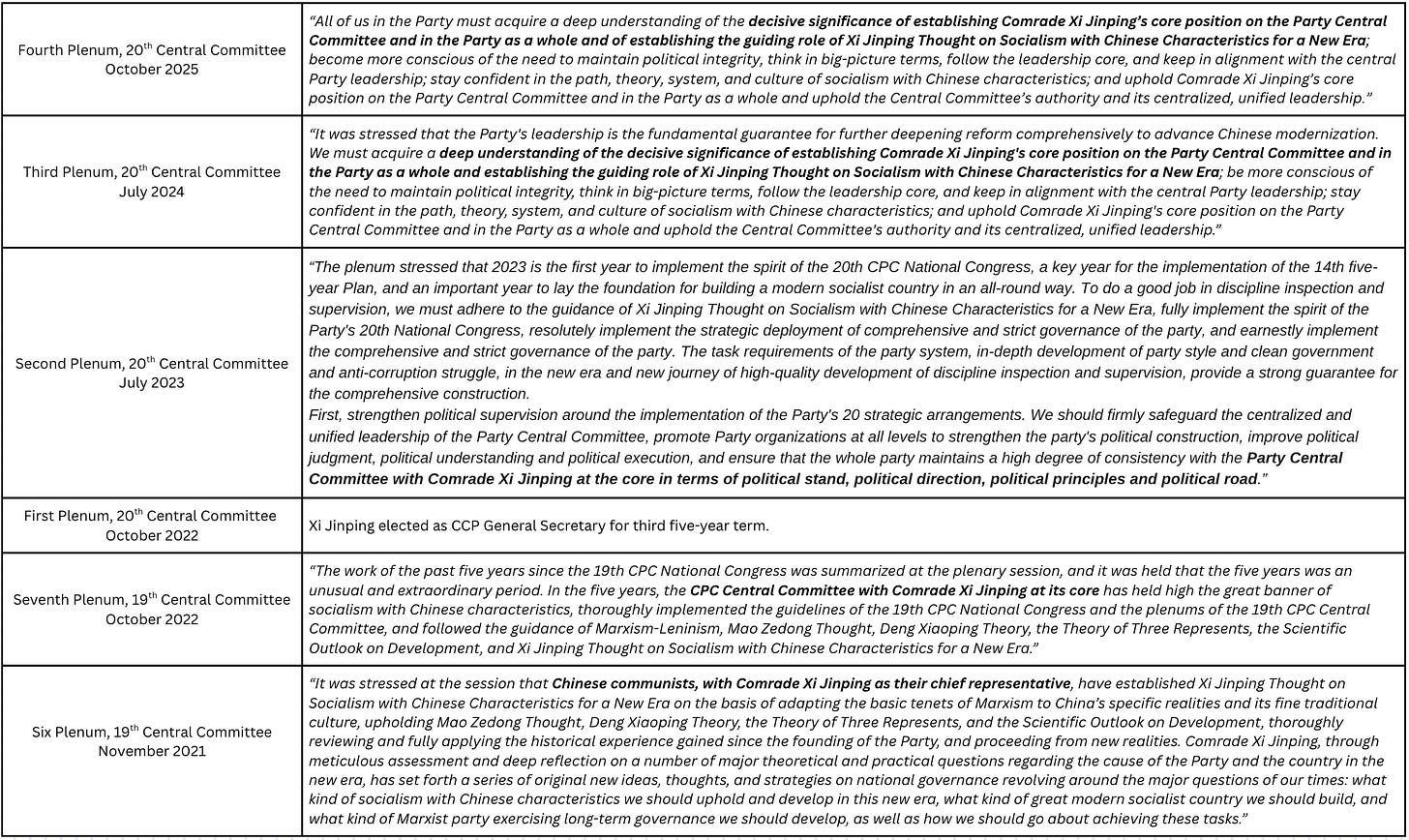
Second, the diminished presence of the People’s Liberation Army (PLA) officers on the Central Committee, its lowest level of attendance in years due to the dramatic purges initiated last week, testified to Xi’s impact on the Party. As noted by former editor-in-chief of the South China Morning Post, Wang Xiangwei, the absence of PLA officials was even more pronounced as replacements at the event for the nine PLA officers purged last week all came from non-PLA alternates.
Xi further left his mark on the diminished PLA by using the plenum to announce Zhang Shengmin as replacement for recently purged He Weidong as the vice chair of the Central Military Committee (CMC). This position makes Zhang the second in command of the armed forces. This is especially significant as Zhang Shengmin most recently served as the PLA’s top anti-corruption officer, a role which has made Zhang a key instrument of Xi’s purges.
Five-Year Plan Addressed:
The top priorities for the upcoming 15th Five-Year Plan from 2026-2030 focus on cultivating self-reliant economic development and continuing economic growth through advances in technology, and increased domestic consumption.
“China should build a modernized industrial system and reinforce the foundations of the real economy, said the communique.
“The country should achieve greater self-reliance and strength in science and technology and steer the development of new quality productive forces.
“It should build a robust domestic market and work faster to foster a new pattern of development, said the communique.
“China should move faster to develop a high-standard socialist market economy and boost the momentum for high-quality development.
“The country should promote high-standard opening up and create new horizons for mutually beneficial cooperation.
“It should accelerate agricultural and rural modernization and take solid steps to advance all-around rural revitalization.
“China should refine its regional economic layout and promote coordinated regional development, according to the communique.”
In the next five years China is aiming to achieve breakthroughs in advanced technology, such as semiconductors, aerospace, and artificial intelligence, that will allow it to break free of constraints on its development imposed by Western technology restrictions.
China also hopes to fix structural problems in its economy driven by “involution.” “Involution,” is a destructive competitive process in which Chinese businesses compete for market share by depressing prices through overproduction. This race to the bottom dynamic kills the profitability of businesses and risks the sustainability of many industries, ranging from construction to electric vehicles.
Involution is driven, in part, by the orientation of China’s economy toward exporting goods combined with weak domestic consumption habits. The CCP hopes to coax Chinese consumers to absorb a greater portion of the goods Chinese businesses are creating to keep the economy growing and avoid a potential scaling back of industries.
The five-year plan will go through several more steps over the next few months, from recommendations to outlines, before receiving approval sometime in early 2026.
3. CHINA ACCUSES US OF HACK ON NATIONAL TIME KEEPER
This week China’s Ministry of State Security announced that it had evidence the US National Security Agency (NSA) had conducted a long-term cyber espionage campaign targeting its National Time Service Center. The National Time Center is part of the Chinese Academy of Sciences and maintains standard “Beijing Time.” Beijing claims the NSA has targeted the facility since 2022 with 42 different cyber tools and techniques.
Takeaways:
China’s state media outlet Global Times, which broke the story, described the significance of the National Time Center and the consequences of an attack on it as follows:
“Located in Xi’an, Northwest China’s Shaanxi Province, the National Time Service Center generates, maintains, and broadcasts ‘Beijing Time.’ It provides high-precision time services for sectors such as national communications, finance, electric power, transportation, surveying and mapping, and national defense, while also supplying key data for calculating the Coordinated Universal Time (UTC).
“The center independently developed a world-leading autonomous time measurement system and built a key national science and technology facility - the High-Accurate Ground-based Time Service System. Damage from a cyberattack could jeopardize the secure and stable operation of “Beijing Time,” potentially leading to severe consequences such as network communication failures, financial system disruptions, power outages, transportation paralysis, and aerospace launch. It could even throw global timekeeping into chaos, resulting in incalculable harm and losses.”
Observers, such as Alexander Martin of Recorded Future News, a prominent cybersecurity news outlet, noted that the accusation follows numerous complaints by Western nations about China’s own cyber espionage and may represent an attempt to deflect criticism through whataboutism.
Martin also observed that the language of the accusation, which simultaneously emphasized both the duration and complexity of US operations and their lack of ingenuity, appears designed to minimize the failure of China’s security services to detect a multi-year cyber campaign that compromised critical infrastructure.
4. IRAN RESUMES CONSTRUCTION AT FORMER NUCLEAR RESEARCH SITE
A report released by the Institute for Science and International Security on October 20, identified new construction at the Taleghan 2 site located at the Parchin military complex outside Tehran. Taleghan 2 was part of the AMAD project, a secret Iranian nuclear weapons research program begun in 1989 and discontinued in 2003.
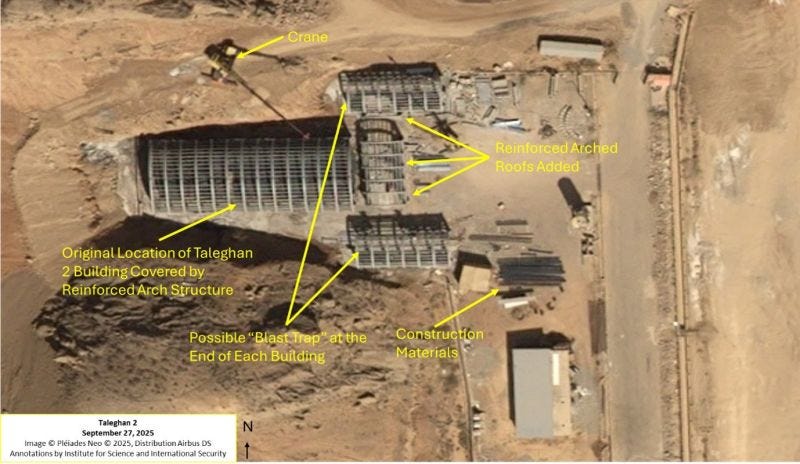
Takeaways:
While construction at Taleghan 2 is not itself an indication that Iran is restoring nuclear weapons research at the site, there are indications that both the US and Israel believe the site will be used for those purposes in the future.
The Israeli military struck and damaged the site in October 2024, believing that Iran had begun research on conventional explosive devices used to detonate nuclear weapons. The strike followed July 2024 warnings to Iran by the US to cease suspicious activities related to weaponization of nuclear materials.
The new construction at the site, intensified in the summer of 2025 after the 12-Day War, features potential blast mitigation features, suggesting Iran is preparing to defend whatever work is conducted there from future US or Israeli strikes.
5. NORTH KOREA CONDUCTS NEW MISSILE TEST
On October 22, North Korea launched multiple ballistic missiles from the Ryokpho District, in Pyongyang, to the northeast, reportedly hitting a target on Kwesang Peak in Orang County, North Hamgyong Province. North Korea has claimed the launch was a successful test of its new hypersonic missiles. The North did not name the missile system involved, however, the South Korean military believes the missile to be from the Hwasong-11 series of short-range ballistic missiles.
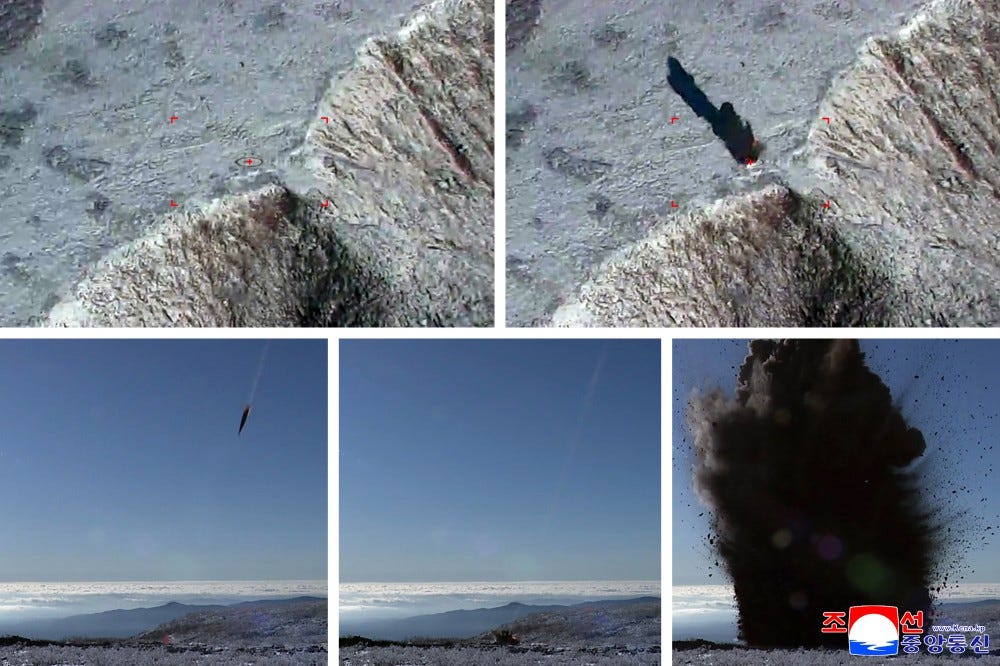
Takeaways:
This most recent missile test precedes the upcoming Asia-Pacific Economic Cooperation (APEC) Summit in South Korea from October 31-November 1. The test is a signal that North Korea, while left out of the gathering, retains its own means of influencing policy in the region.
The test may also be a message to President Trump that North Korea is awaiting a response from the US on its previous offers to resume dialogue in exchange for recognition of its nuclear program and an end to the US policy of pursuing a Korean peninsula free of nuclear weapons.
It’s not clear that the missile system tested is actually an advanced hypersonic weapon. Hypersonic weapons are a blanket term generally used to describe Hypersonic Glide Vehicles (HGVs), a highly sophisticated maneuverable missile that travels at hypersonic speeds.
However, many conventional ballistic missiles are colloquially referred to as hypersonic missiles because they travel at hypersonic speeds, though they lack the maneuver that make HGVs especially dangerous and difficult to intercept. The Russian Kh-47M2 Kinzhal is an example of a speedy ballistic missile which is described as a hypersonic weapon though it is not a HGV.
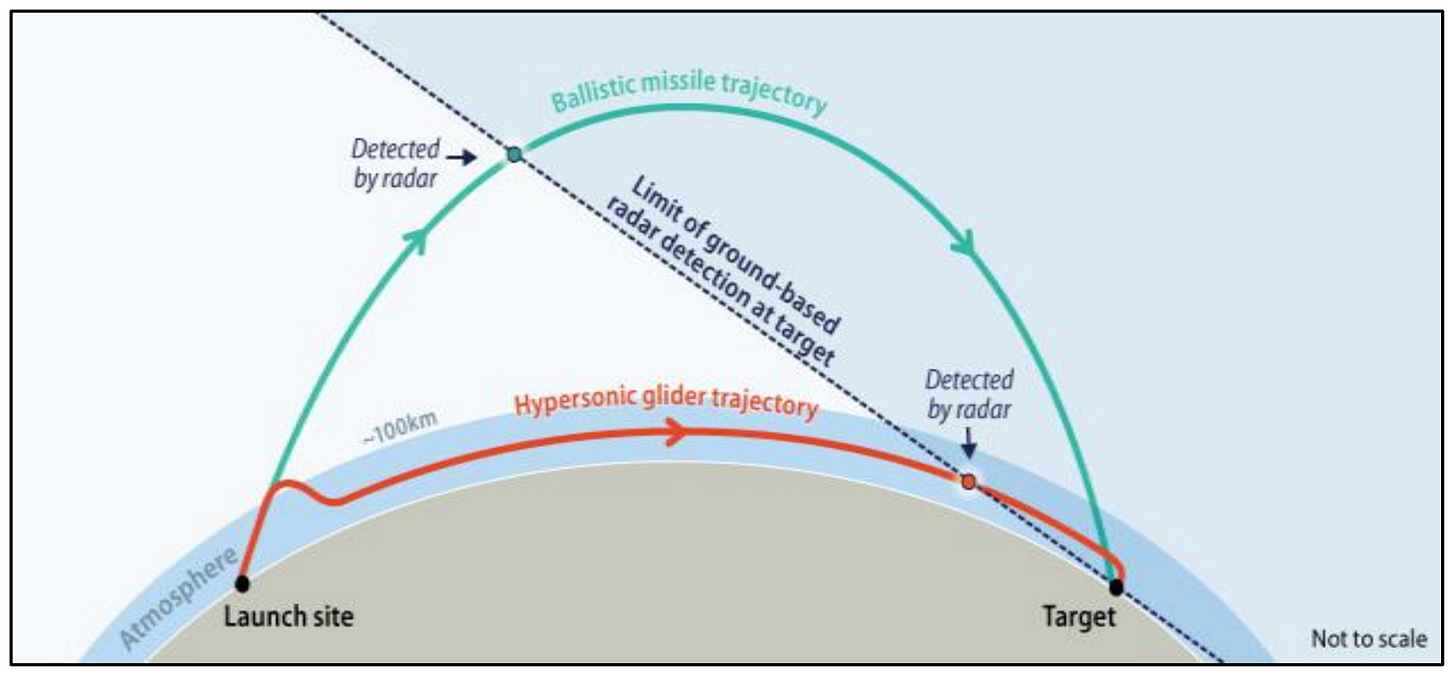
Difference in flight patterns between ballistic missiles (green) and hypersonic glide vehicles (red). Source: The Economist “Gliding missiles that fly faster than Mach 5 are coming,” April 6, 2019, via CRS Report “Hypersonic Missile Defense: Issues for Congress,” May 2025 It is possible that North Korea may be conflating the two terms (like Russia has), in addition to parading models of hypersonic gliders at its recent 80th anniversary celebration of the founding of the Workers’ Party of Korea, to exaggerate its technological achievements.




